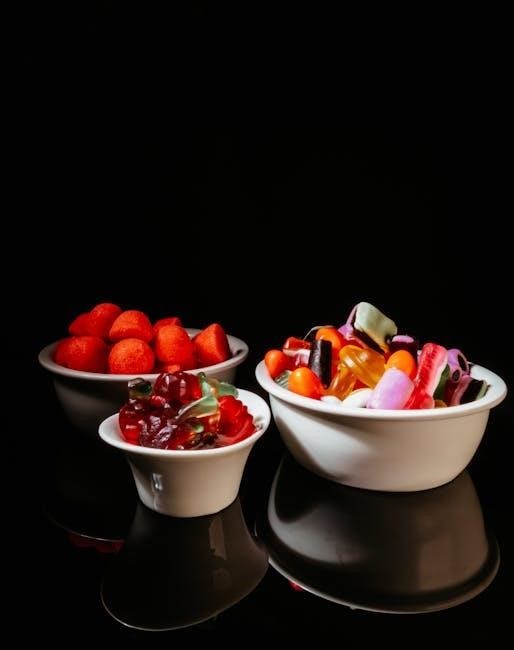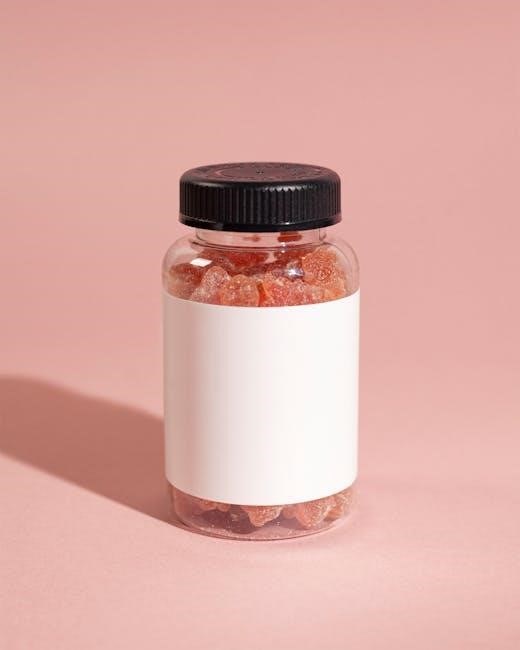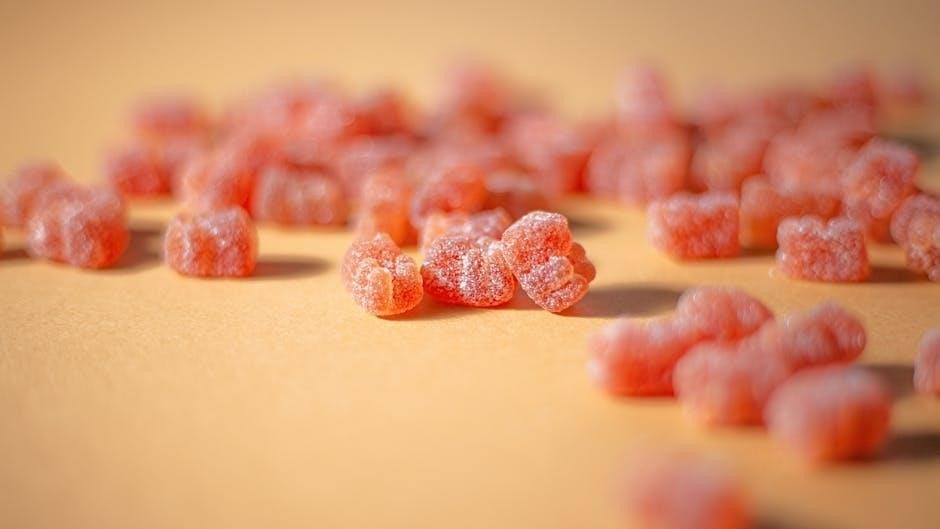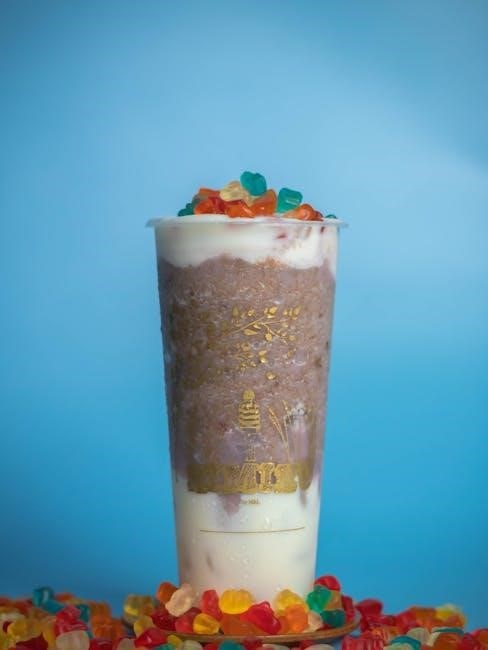The Gummy Bear Osmosis Experiment is a fun, interactive way to demonstrate osmosis using gummy bears. It shows how water moves through a semipermeable membrane, making it an engaging educational tool for understanding this biological process.
1.1 What is Osmosis?
Osmosis is the movement of water molecules from an area of high concentration to an area of low concentration through a semipermeable membrane. This natural process is essential in biology, influencing how cells absorb water. In the Gummy Bear Osmosis Experiment, osmosis is visually demonstrated as gummy bears absorb water, swelling in size. This experiment simplifies the concept, making it accessible for educational purposes while showcasing the fundamental biological process at work.
1.2 Why Gummy Bears are Ideal for Demonstrating Osmosis
Gummy bears are ideal for demonstrating osmosis because they are made of gelatin, a semipermeable substance that allows water molecules to pass through. Their small size, soft texture, and ability to absorb water make them perfect for observing visible changes. The gelatin structure mimics biological membranes, making the experiment relatable to cellular processes. Additionally, gummy bears are inexpensive, easy to handle, and provide quick, noticeable results, making them an engaging and effective teaching tool for understanding osmosis.

Materials Needed for the Experiment
Gummy bears, water, salt, sugar, vinegar, measuring cups, rulers, scales, beakers or containers, paper, and pens are essential for conducting the osmosis experiment effectively.
2.1 Gummy Bears
Gummy bears are the star of this experiment due to their gelatin composition, which acts as a semipermeable membrane. They are ideal for demonstrating osmosis because they absorb water easily, making changes in size and mass noticeable. Their small size, chewy texture, and affordability make them perfect for hands-on learning. Plus, they come in various shapes and sizes, allowing for consistent measurements and comparisons across different liquids.
2.2 Liquids for Testing (Water, Salt Water, Sugar Water, Vinegar, etc.)
Various liquids like water, salt water, sugar water, and vinegar are used to test osmosis in gummy bears. These liquids vary in solute concentration, affecting water movement. Water causes the gummy bears to swell due to high water absorption. Salt water and sugar water, with higher solute concentrations, can cause shrinkage. Vinegar and other solutions may alter texture or cause expansion. These liquids provide diverse environments to observe osmotic effects, making the experiment engaging and educational for understanding water movement across a semipermeable membrane;
2.3 Measurement Tools (Ruler, Scale, etc.)
Essential tools for measuring changes in gummy bears include a ruler to measure length and width, and a scale to record mass before and after soaking. These tools help quantify physical changes caused by osmosis. Accurate measurements ensure reliable data collection, allowing students to track how different liquids affect the gummy bears’ size and mass. Consistent use of these tools provides a clear understanding of osmotic effects, making the experiment both educational and engaging for learners of all ages.

Step-by-Step Procedure
Prepare gummy bears, soak them in selected liquids, and measure changes using rulers and scales to track size, mass, and texture changes over time.
3.1 Preparing the Gummy Bears
Rinse the gummy bears gently to remove any surface sugar. Use a ruler to measure their initial length and width, and a scale to record their mass. Document these measurements to compare with post-soaking results. Ensure the gummy bears are dry before proceeding to avoid initial moisture interference. This preparation step ensures accurate and consistent data collection for the experiment.
3.2 Soaking the Gummy Bears in Different Liquids
Place each gummy bear into separate containers filled with different liquids like water, salt water, sugar water, or vinegar. Ensure they are fully submerged; Let them soak for 24-48 hours. For accurate results, maintain consistent soaking times across all samples. Avoid overcrowding the containers to prevent gummy bears from sticking together. Regularly observe and note any visible changes during the soaking period to capture detailed data for analysis.
3.3 Measuring and Documenting Changes
After soaking, remove the gummy bears from the liquids and gently pat them dry with a paper towel. Use a ruler to measure their length and width, and a scale to record their mass. Note any changes in size, shape, or texture. Document observations, including whether the gummy bear expanded, shrunk, or remained unchanged. Take photos or draw diagrams to visually capture the transformations. This step is crucial for analyzing how different liquids affect osmosis in the gummy bears.

Observations and Results
Gummy bears soaked in water typically expand due to water absorption via osmosis, while those in salt water shrink. Texture changes are also noticeable, with water-soaked bears becoming softer and saltwater-soaked ones harder. These observations clearly demonstrate the effects of osmotic pressure and solute concentration on water movement in gelatin-based candies.
4.1 Changes in Size and Mass
Gummy bears exhibit noticeable changes in size and mass when soaked in different liquids. Those placed in water absorb moisture through osmosis, causing them to swell significantly. In contrast, gummy bears soaked in saltwater lose water, shrinking in size. The mass increases in water and decreases in saltwater due to water absorption or loss. These visible changes provide clear evidence of osmosis at work, making the experiment an engaging way to study water movement and solute concentration effects.
4.2 Texture and Appearance of Gummy Bears After Soaking
After soaking, gummy bears undergo significant texture and appearance changes. Those in water become swollen, soft, and gelatinous, often losing their original shape. In saltwater, they shrink and harden due to water loss. Some may develop a sticky surface or become misshapen. These changes are due to the movement of water and solutes through the gelatin-based structure, visually illustrating the effects of osmosis and differing solute concentrations on the gummy bears’ physical properties.
4.3 Comparison Across Different Liquids
Gummy bears soaked in various liquids exhibit distinct changes, highlighting the role of solute concentration in osmosis. In water, they swell significantly due to water absorption. In saltwater, they shrink and harden as water leaves. Sugar water may cause moderate swelling, while vinegar can soften them due to acid interaction. These comparisons illustrate how different solutes affect water movement and the gummy bears’ physical properties, providing a clear visual demonstration of osmotic effects in varied solutions.
The Science Behind the Experiment
The experiment demonstrates osmosis, where water moves through the gummy bear’s gelatin membrane. High water concentration outside the bear drives water inward, causing swelling. Conversely, in saltwater, water moves out, shrinking the bear, illustrating how solute concentration affects osmotic flow. This visualizes the fundamental biological process of osmosis in a simple, engaging way.
5.1 How Osmosis Works in Gummy Bears
Osmosis in gummy bears occurs as water molecules pass through the gelatin membrane. The gummy bear, made of gelatin, acts as a semipermeable barrier. When submerged in water, water moves into the bear due to higher water concentration outside, causing it to swell. In saltwater, the opposite happens—water exits the bear, shrinking it. This movement depends on solute concentration, demonstrating how osmosis balances water across a membrane, a key concept in biology and physiology.
5.2 Role of Gelatin in Osmosis
Gelatin, a protein, forms a semipermeable membrane in gummy bears, essential for osmosis. Its mesh-like structure allows water molecules to pass while blocking larger solutes. This property enables water to move into or out of the gummy bear based on concentration gradients, making gelatin crucial for observing osmosis. It maintains the bear’s structure during the experiment, ensuring the process is visible and effective.
5.3 Effect of Solutes on Water Movement
Solutes in liquids significantly influence water movement during osmosis. In the gummy bear experiment, solutes like salt or sugar in water create concentration gradients. When placed in saltwater, the high solute concentration outside the gummy bear prevents water from entering, sometimes causing the bear to shrink. Conversely, in pure water, water flows into the gummy bear, swelling it. The presence and concentration of solutes determine the direction and rate of water movement through the gelatin membrane.

Educational Value of the Experiment
The Gummy Bear Osmosis Experiment is an engaging, hands-on activity that teaches kids about osmosis, STEM concepts, and scientific observation. It fosters curiosity and critical thinking.
6.1 Teaching Kids About Osmosis
The Gummy Bear Osmosis Experiment is a simple yet effective way to teach children about osmosis. By observing how gummy bears absorb water, kids can visualize water movement through a semipermeable membrane. This hands-on activity makes complex scientific concepts accessible and engaging. It encourages curiosity and helps students understand how osmosis works in real-life scenarios, aligning with STEM education goals and fostering a deeper appreciation for biological processes.
6.2 Promoting STEM Learning Through Hands-On Activities
Hands-on activities like the Gummy Bear Osmosis Experiment are a cornerstone of STEM education, fostering critical thinking and problem-solving skills. By engaging in experiments, students actively learn scientific concepts, such as osmosis, in an interactive and memorable way. This approach encourages collaboration, curiosity, and creativity, preparing young learners for real-world applications of science, technology, engineering, and mathematics. It also builds confidence and a love for learning through tangible, fun experiences.

Variables to Explore
Key variables to explore include the type of liquid, soaking time, and gummy bear size. These factors significantly influence osmosis rates and experimental outcomes, offering deeper insights.
7.1 Effect of Different Liquids on Gummy Bears
Testing various liquids like water, saltwater, sugar water, and vinegar reveals how solute concentration affects osmosis. Gummy bears absorb more water in low-solute solutions, expanding significantly, while high-solute liquids cause shrinkage. This variation helps students hypothesize and observe how different solutes influence water movement through the gelatin membrane. The experiment clearly demonstrates the impact of solute concentration on osmosis, making it easier to visualize and understand this scientific concept through hands-on exploration.
7.2 Impact of Time on Osmosis
The duration of soaking significantly affects osmosis in gummy bears. Shorter soak times result in minimal size changes, while longer periods allow more water absorption, leading to maximum swelling. Observing gummy bears at intervals, such as every few hours, shows gradual changes. Over time, the gummy bear reaches equilibrium, where water inflow equals outflow. This demonstrates how time influences the rate and extent of osmosis, providing insights into the dynamics of water movement through the gelatin membrane.

Fun Variations and Extensions
8;1 Using Different Types of Candy
Experimenting with candies like gummies, sour candies, or chewy snacks offers variations to observe osmotic effects. This adds fun and educational diversity to the classic gummy bear setup.
Exploring osmotic effects with various candies like sour candies, chewy snacks, or fruit-based gummies offers a fun twist. Each candy type reacts differently due to its composition, allowing students to compare changes in size, texture, and mass. This variation encourages creativity and deeper understanding of osmosis, making the experiment more engaging and educational for all participants while maintaining its scientific integrity and visual appeal.
8.2 Creating a Hypothesis and Testing It
Encourage students to formulate hypotheses about how gummy bears will react in different solutions. This step fosters critical thinking and scientific inquiry. By predicting outcomes, students engage deeply with the experiment, observing how variables like liquid type or soaking time affect results. Testing hypotheses helps refine understanding of osmosis and its real-world applications, making the experiment both educational and enjoyable while fostering analytical skills and curiosity.

Safety Tips and Precautions
Ensure clean workspace, handle sharp objects carefully, and avoid choking hazards with small gummy bears. Supervise children and use protective gloves when handling chemicals or hot water.
9.1 Handling Sharp Objects and Chemicals
When conducting the gummy bear osmosis experiment, handle sharp objects like knives or scissors with care to avoid accidents. Ensure children are supervised by adults during such tasks. Use protective gloves when handling chemicals like salt, sugar, or vinegar to prevent skin irritation. Store all materials safely after use to maintain a secure environment. Always prioritize caution to ensure a safe and enjoyable learning experience for everyone involved.
9.2 Ensuring Cleanliness and Hygiene
Cleanliness is crucial to prevent contamination and ensure accurate results in the gummy bear osmosis experiment. Always wash hands before handling materials. Use clean containers and utensils to avoid impurities. After the experiment, dispose of used gummy bears and liquids properly; Clean all surfaces and tools with soap and water to maintain hygiene. This ensures a safe and controlled environment for conducting the experiment and observing clear results.
The gummy bear osmosis experiment effectively demonstrates the process of osmosis through a fun, hands-on activity. It helps visualize how water moves across semipermeable membranes and highlights the impact of solute concentration on water absorption, making it an excellent educational tool for understanding biological processes in an engaging way.
10.1 Summary of Key Findings
The gummy bear osmosis experiment clearly demonstrates how water moves through a semipermeable membrane, with gummy bears absorbing water and increasing in size. Gelatin acts as a membrane, allowing water to enter while retaining the candy’s structure. Soaking in salt water caused shrinkage due to high solute concentration, while vinegar showed minimal size change but altered texture. This experiment simplifies complex concepts, making it an ideal teaching tool for understanding osmosis and its real-world applications in a fun, hands-on manner.
10.2 Encouraging Further Exploration of Osmosis
This experiment sparks curiosity and encourages further exploration of osmosis. Students can investigate how varying soaking times or different liquids affect gummy bears. Exploring real-world applications, such as osmosis in cells or water purification, deepens understanding. Encouraging predictions and hypotheses fosters critical thinking and scientific inquiry, making this a valuable learning experience for students of all ages.
References and Resources
Recommended reading materials and online guides provide detailed instructions and scientific explanations for the gummy bear osmosis experiment. Explore PDFs like Gummy Bear Osmosis Lab and websites offering step-by-step procedures and educational insights.
11.1 Recommended Reading Materials
For a deeper understanding, explore resources like the Gummy Bear Osmosis Lab PDF, which details procedures and results. Websites such as Science Dipity offer comprehensive guides. These materials provide step-by-step instructions, scientific explanations, and educational insights, making them invaluable for students and educators. They also include tips for variations and extensions of the experiment, ensuring a well-rounded learning experience.
11.2 Links to Detailed Experiment Guides
Various online resources provide detailed guides for the gummy bear osmosis experiment. Websites like Science Dipity and educational platforms offer step-by-step instructions. Additionally, PDF documents such as Michigan’s Gummy Bear Osmosis Lab are excellent resources. These guides include materials lists, procedures, and expected outcomes, making them ideal for teachers and students conducting the experiment.
